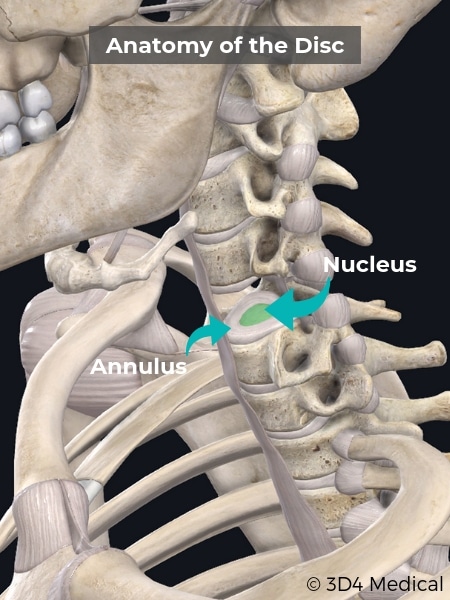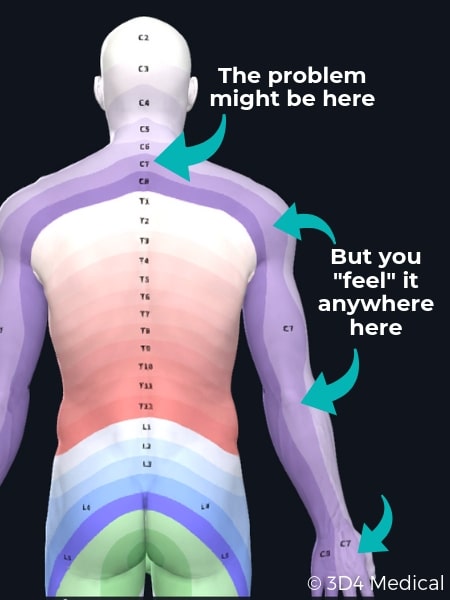Cervical Disc Bulge or “Neck Disc Bulge” is a relatively common form of neck pain, shoulder pain or arm pain. Here are the things you need to know…
Overview of Relevant Structures
In order to understand what a disc bulge is and why it occurs we need to discuss the anatomy of this structure.

An intervertebral disc (more commonly known as a disc) is a structure that sits in between each of the spinal bones (a.k.a. vertebrae). Its main functions are to help hold the spine together and to act as a shock absorber.
A disc has two parts that we need to be aware of – the annulus fibrosus and the nucleus pulposus.
The annulus fibrosus is the firm but flexible outer aspect of the disc which is composed of several layers. The nucleus pulposus is the central aspect which is gel-like in nature.
If we think of a disc like a hot jam donut, the annulus fibrosus is the dough and the nucleus pulposus is the jam in the centre.
What is Cervical Disc Bulge?
A cervical disc bulge occurs when there are micro tears in the annulus fibrosus and the nucleus pulposus pushes out. This causes the disc to become disfigured. The change of shape may result in direct pressure on the nerves that exit your neck and cause nerve pain or other associated symptoms. Most commonly experienced symptoms associated are neck pain, headache and shoulder/arm pain.
How Does This Occur?
- There are many factors that may predispose someone to developing a neck disc bulge:
- acute trauma (e.g. motor vehicle accident)
- lifting weights with poor technique
- sitting for long periods of time regularly (e.g. desk work with poor ergonomics)
- being overweight
- older age
What are the Symptoms of Cervical Disc Bulge?

- Neck pain (may be described as an ache, burning, shooting or stabbing)
- Neck stiffness and restriction in range of motion
- +/- Headache, particularly in the back of the head
- Tenderness when pressing on the neck
- Referred/shooting pain into the shoulders and upper back
- Numbness, tingling or shooting pain into the arms
- Weakness and decreased reflexes in the arms
How Is a Cervical Disc Bulge Managed?
After the diagnosis is made, a treatment plan will be discussed with you. In many cases a combination of manual therapy and home exercises will help you return to normal function. If the pain is severe and you are struggling to sleep, pain medications (analgesics and NSAIDs) may be useful as suggested by your General Practitioner.
Manual Therapy may involve:
- stretching of the muscles
- massage
- gentle mobilisation of the neck and upper back joints
Some of the more common home exercises for this type of injury include:
- stretching of the neck and shoulder muscles
- exercises to strengthen the muscles in the front of your neck and upper back
- self mobilisation exercises for your neck and back
***every individual case is managed differently so you may require a different form of management***
How Is It Diagnosed?
Diagnosis may be based on the history (e.g. location, onset and type of pain) along with physical examination. Diagnostic Imaging may be required to assist with diagnosis or to check the progression of your recovery.
Typically, Magnetic Resonance Imaging (MRI) or Computerised Tomography (CT) scans are the preferred method of imaging for disc pathologies.
